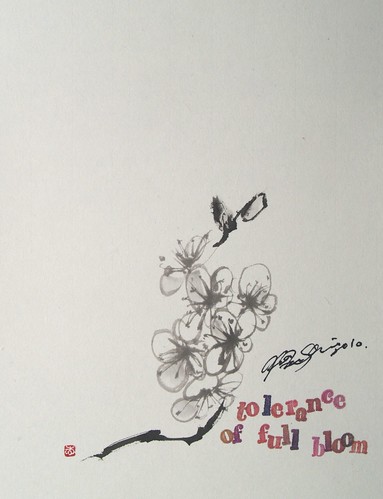Chrysanthemum, wow we call it ‘Kiku’. Too long word to remember in English 🙂
Anyway, the chrysanthemum recalls me of the funeral. At the funeral, the photo of the dead is displayed surrounded with lots of small yellow chrysanthemum.
The word for ‘kiiku’, chrysanthemum in Japan, was used for the name(both boys and girls ) until seventy or eighty year’s ago(the grand father age). There is a Kitano’s film called ‘KIKU-jiro no Natsu’, the summer of KIKU-jiro. Jiro is often used for the second sun’s name.
So, what I want to say here, the chrysanthemum is not pop or cute flower which you might not choose ones for the girlfriend’s birthday gift.
Tips:
1. Petal :
- Light ink with small squared the tip of the hair of the brush(fude-saki). You squeeze fudesaki after dipping the ink.
- The squared fudesaki depict the round tip of the petal.
- Draw the center part of the flower. This part of the flower still like a bud, so the drawing stroke must be short and hard touch. It has little curving and sweeping at the last part of stroke.
- You take a half breath at the first touch of fudesaki on the paper. That moment gives the round shape of the petal tip and more importantly the blacker color of the tip.
- Eight strokes for the center part.
2. Surrounding petals :
- Petals around the center are longer and winding.
- The shape of fudesaki is the same as well.
- Every stroke must be toward the center. Think the real petals are connected at the center and each petal grow from the one point.
3. Leaves :
- Almost the same as asagao leaves drawing.
- One leaf is depicted by eight strokes. Top left, middle left, the bottom, the middle right, then top right. Two for each small part of leaves.
- The bottom part ; You bring the body of the brush (jiku) down toward yourself at the last move of the stroke. At that time, the body part of fude hair must touch on the paper. You pull fude up, then the round shape will show up. That is the tip of the leaf. Use fude as a stamp.
- Wash fude.
- Bend the fude hair on the cloth.
- Put the very black ink on the ink stone on the behind of the bent fuse hair.
- Then, draw the thin vein line on the leaf.
- The line won’t show up until the ink becomes dry.
- Draw lighter black leaves behind very black one. Remember, draw black one first.
Stems:
- Wash fude and bend the fude hair on the cloth.
- Put the very black ink on the ink stone.
- Draw stem lines.
Enjoy 🙂







